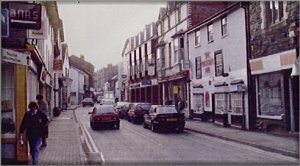| Driving Round Builth Wells |
 Under the shadows of the castle a town grew up that took its name from the church which had been built outside the castle walls. The church was dedicated to St. Mary, as was the case wherever a Norman castle had been built (compare Brecon and Hay for example). The town consequently became known as Llanfair ym Muallt - St. Mary's in the Cantref of Builth. Under the shadows of the castle a town grew up that took its name from the church which had been built outside the castle walls. The church was dedicated to St. Mary, as was the case wherever a Norman castle had been built (compare Brecon and Hay for example). The town consequently became known as Llanfair ym Muallt - St. Mary's in the Cantref of Builth.
Gradually the embryonic town grew in importance and size, so much so that in 1277 it became a Borough Town it was granted a Royal Charter by Edward I. As time passed, the town, like so many other towns dropped its former name and took on the name of the territory it controlled. Thus Llanfair ym Muellt became Buellt, then Buallt which in turn became anglicized into Bealt and finally Builth, with the name in Welsh being Llanfair ym Muallt.
The following four centuries saw the sporadic growth of a small market town which by 1800 had a population close to 700. This development however, did not occur without its fair share of dramas.
In the 1350's, it is almost certain that the town experienced the Great Plague - The Black Death. Local tradition tells us that when the Plague ravaged Builth the people living in the countryside surrounding the town left food and provisions for the townspeople on the banks of a brook to the west of the town. In return, Builth's inhabitants threw money to pay for the goods into the brook in an attempt to prevent the spread of the Plague. As a result the brook became known as 'Nant Yr Arian' or 'The money Brook' a name which remains today.
Possibly the most important drama occured in 1690 (or perhaps 1691?) when the houses of some forty families were destroyed by fire. The fire is thought to have raged for about five hours resulting in more than £12,000 damage. Letters Patent were granted by the Crown enabling the sufferers to collect alms from those charitably disposed. Unfortunately, only a few hundred pounds were collected and so much misapplied that only one house was rebuilt from this fund - this is possibly the modern-day White Horse Hotel. It has also been suggested that materials taken from the redundant and decaying castle were used to rebuild the fire ravaged town.
|
|
| Submitted By: |
Henry Nurdin
Severn Media Group |
| Address: |
Unit 86, Mochdre Enterprise Park, Newtown, Powys, SY16 4LE |
| Phone: |
|
| Website: |
http://www.severnmediagroup.com
|
| Email: |
|
|
|
|
|



